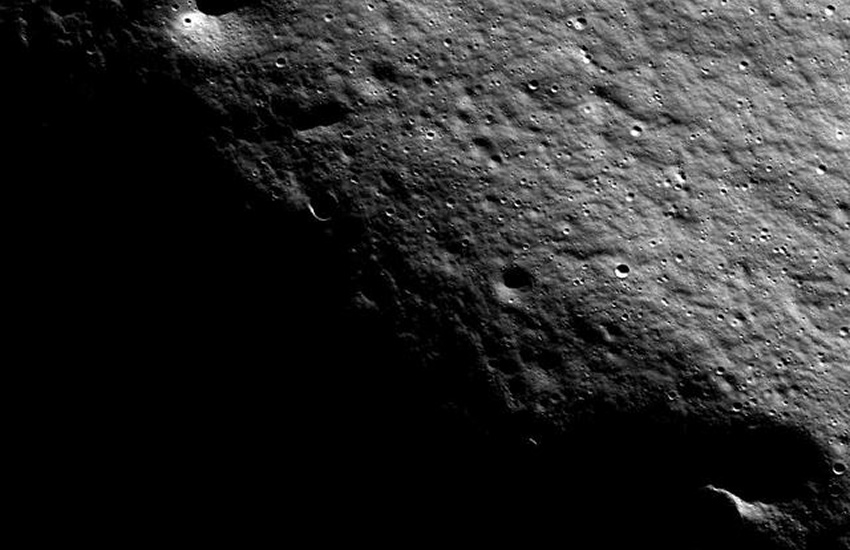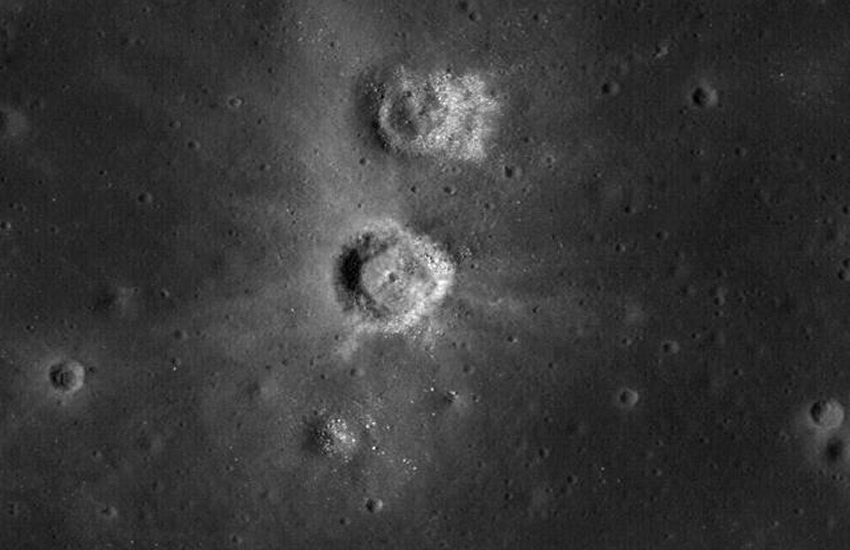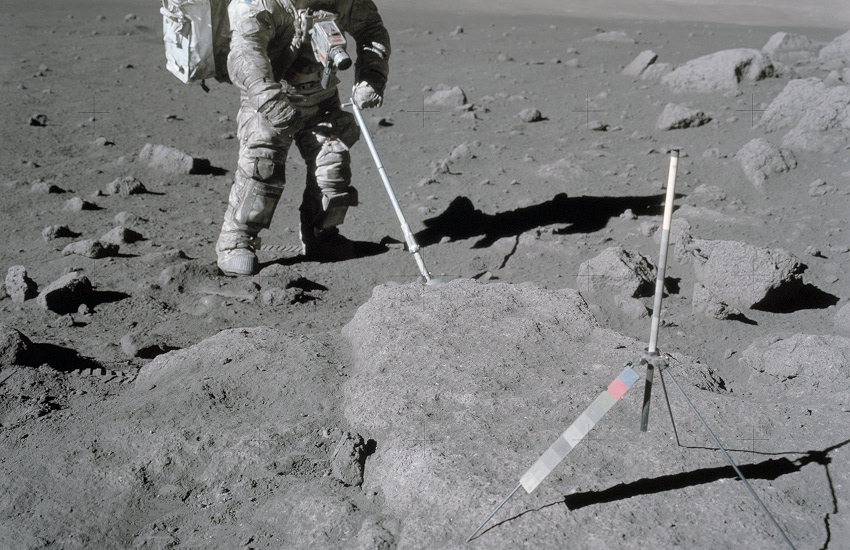Have you ever wondered what secrets lie within the dusty, rocky surface of the Moon? Space exploration has taken humanity far beyond Earth’s atmosphere, but as we set our sights on long-term lunar resource utilization, understanding the Moon’s surface becomes essential. And a key element in these efforts is – lunar regolith.
But what exactly is this fine, powdery material covering la Luna, and how could it be used for future space endeavors? Let’s dig into why it might just be the key to our presence among the stars.
What Is Lunar Regolith?

Lunar regolith is the loose, unconsolidated, and fragmented material covering the Moon’s entire solid bedrock. Unlike Earth’s soil, which is enriched with organic matter, the composition of lunar soil is entirely inorganic. This layer of dust and rock fragments was formed over billions of years by constant meteorite impacts, solar wind exposure, and space weathering (an umbrella term encompassing various processes affecting any object subjected to the harsh conditions of space).
In mare regions, the regolith is generally about 4 to 5 meters thick, while in highland areas, it can reach depths of even 10 to 15 meters. Beneath this layer lies what is known as the “megaregolith” – a region composed of fractured bedrock, ejecta deposits, and large rock fragments formed by ancient impacts.
How Does Lunar Regolith Form?
Unlike Earth, the Moon has no atmosphere to protect it from constant bombardment by micrometeorites. These high-speed impacts pulverize rocks, creating a fine, powdery layer known as lunar dust. Over millions of years, this process has led to the accumulation of regolith, which varies in thickness – ranging from a few meters in some areas to over 10 meters in others.
Earth vs. Moon: A Tale of Two Surfaces
The differences between Earth’s surface and the Moon’s landscape are striking. Unlike Earth, where atmospheric conditions, water flow, and life continually reshape the terrain, the Moon remains largely unchanged. Geological activity, which drives Earth’s dynamic features, such as volcanoes, earthquakes, and plate tectonics, is very rare on the Moon.
There is geological evidence of ancient volcanic activity on the Moon during its early history, particularly between approximately 4.2 and 3 billion years ago. A 2024 study analyzed samples retrieved by China’s Chang’e-6 mission, which contained basalt fragments dating to about 2.8 billion years ago, suggesting that volcanic activity on the Moon’s far side persisted longer than previously confirmed. However, its crust and mantle have been cold and rigid for a long time, preventing the internal movements that renew Earth’s surface.
As a result, while Earth’s crust is relatively young (in space terms, at least), with nearly 80% of its surface being less than 200 million years old, more than 99% of the Moon’s surface dates back over 3 billion years, with a significant portion even exceeding 4 billion years in age. This stark contrast makes the Moon a time capsule, preserving the scars of ancient impacts that have long since been erased from Earth’s surface.
This also leads to differences in their chemical makeup. The Moon’s surface is remarkably arid, resulting in a lack of water-rich minerals commonly found on Earth. This absence of moisture means that crucial hydration-dependent minerals, such as clay and mica, are virtually nonexistent in lunar regolith.
Lunar Regolith Composition: What’s in It?

The Moon’s regolith is a complex, heterogeneous material formed by billions of years of meteorite impacts, solar wind implantation, and micrometeorite “gardening” (the continuous process by which the surface of a celestial body is gradually broken up and mixed due to the constant bombardment of tiny meteoroids, i.e., micrometeorites, at extremely high velocities causing tiny explosions that pulverize and churn the regolith).
Its composition varies depending on the region but primarily consists of rock fragments, volcanic rock, glass beads, and mineral grains. Scientists have been able to figure this out from Apollo samples, lunar meteorites, and remote sensing data. Some of the key components of this Moon’s layer include:
-
Major Constituent Elements
- Oxygen (O): Oxygen is the most abundant element, typically constituting about 40–45%. It is mainly bonded with other elements in silicate minerals (e.g., in minerals such as pyroxene, olivine, and plagioclase).
- Silicon (Si): Silicon makes up roughly 20–25% of the regolith by weight. It is a primary component of silicate minerals and is found in structures like quartz (in terrestrial analogs) and in the common lunar minerals pyroxene and olivine.
- Iron (Fe): Iron generally makes up around 8–15% of the regolith. It appears in several forms, including oxides such as Ilmenite and pyroxene, metallic iron (often present as tiny, nanophase particles formed during impact processing and space weathering), and silicates.
- Aluminum (Al): Aluminum accounts for about 5–10% of the material. It is a key component of plagioclase feldspar, particularly in the highlands, where anorthositic rocks (rich in calcium and aluminum) dominate the bedrock.
- Calcium (Ca): Present at approximately 6-7%. Along with aluminum, it is a major constituent of plagioclase feldspar (anorthite), which is prevalent in the lunar highlands.
- Magnesium (Mg): Contributes roughly 5% by weight. Often found in mafic silicate minerals such as olivine and pyroxene, abundant in basaltic regions.
- Titanium (Ti): Its concentration can vary widely, typically from 1% up to 10% in more titanium-rich mare basalts. It is mostly present as part of ilmenite and other titanium-bearing minerals. Its variable abundance is useful for remote sensing studies in mapping lunar surface compositions.
-
Other Elements and Trace Constituents
- Sodium (Na) and Potassium (K): These alkali metals occur in smaller amounts. They are commonly found in feldspar minerals, with sodium occurring in plagioclase feldspars (such as albite) and potassium in potassium feldspars (such as orthoclase). While they are less abundant compared to major elements, they still play a role in the mineral composition of the lunar crust.
- Trace Elements and Rare Earth Elements (REEs): Elements such as chromium (Cr), manganese (Mn), phosphorus (P), and trace rare earth elements (REEs) are present in minute quantities. They can provide clues about the underlying geology of the Moon, as highland rocks generally contain more REEs than the basaltic mare regions.
- Volatile Elements: Lunar regolith is generally depleted in volatiles compared to Earth. However, solar wind implantation has introduced small amounts of hydrogen (H), helium (He), and even traces of carbon (C) into the regolith. These implanted volatiles are not part of the primary mineral structures but are embedded in the grains and glassy rims formed during micrometeorite impacts.
Why Is Lunar Regolith White & Black?

The answer lies in its mineral makeup. The composition of lunar soil changes slightly based on location. Lunar surface material reflects sunlight due to the presence of feldspar, a light-colored mineral that is rich in aluminum and commonly found in Earth’s crust. This mineral gives the highland regions of the Moon their characteristic brightness.
But it’s not all “white”. The maria (lunar plains) have a higher concentration of basaltic material, a dark, dense volcanic rock formed from ancient lava flows largely consisting of dark-colored olivine and pyroxenes. This gives the lunar lowlands their darker coloration and distinct geological characteristics. Additionally, space weathering darkens the regolith over time, but fresh impact sites reveal the lighter-colored material underneath.
Lunar Regolith vs. Lunar Soil vs. Lunar Dust: What’s the Difference?
Although the terms “lunar regolith,” “lunar soil,” and “lunar dust” are often confused or used interchangeably, they actually refer to different aspects of the Moon’s surface material. Lunar soil is technically the finer fraction of regolith, usually referring to particles smaller than a millimeter. In practice, it often denotes subcentimeter particles within the regolith.
Lunar dust, on the other hand, describes the finest particles – those less than 10 to 20 microns in size. These ultrafine grains are problematic because they can become electrostatically charged and cling to surfaces, posing challenges for lunar exploration and equipment maintenance. This seems to be missing on smaller asteroids, however, because there is not enough gravity to keep it attached to the traveling asteroid. But more on that in a minute.
In Earthly comparisons, the majority of lunar regolith samples resemble silty sands that contain pebbles or larger rock fragments, such as cobbles. Many have compared it to fine-grained slag or terrestrial volcanic ash.
The Challenges of Lunar Dust: Why Is It Problematic?

The electrostatically charged lunar dust presents several obstacles for lunar exploration. Its abrasive nature can wear down equipment, clog machinery, and even pose a health hazard to astronauts due to toxic effects. The Apollo missions revealed that lunar dust clung to spacesuits and caused respiratory irritation. Future astronauts exploring the Moon’s surface will need protective measures to counter these harmful effects of lunar dust.
Applications of Regolith: What Can Lunar Regolith Be Used for?
Lunar regolith isn’t just a material covering the Moon’s surface; it’s a powerful and essential resource for future lunar missions. Getting to the Moon has become a reasonable feat with modern-day technology, but transporting all the supplies needed for an extended stay? It can be both costly and sometimes even practically unfeasible.
Instead of trying to bring everything from home, why not use the resources already available on the Moon? To truly thrive during long-term lunar explorations and make them successful, we must learn how to tap into the resource potential of the Moon’s crust. This is where the lunar regolith comes into play.
Researchers are currently exploring several potential applications of regolith, including:
1. Lunar Construction and Building Technologies
One of the most promising uses for lunar material is in construction. Scientists are developing lunar building technologies that utilize regolith bricks made from compacted lunar soil. 3D technology could play a pivotal role in building lunar bases, allowing for the rapid construction of shelters and infrastructure without needing to transport large amounts of material from Earth.
2. Energy Generation and Solar Cells
Research conducted by the European Space Agency (ESA) investigated the possibility of utilizing lunar regolith for heat retention and generating electricity to support future missions involving astronauts, rovers, and landers. Since lunar regolith contains silicon, it could be used to produce solar cells, potentially providing a sustainable energy source for Moon settlements and reducing reliance on Earth-based power supplies.
Blue Origin, founded by Jeff Bezos, has been engaged in creating solar cells and transmission wires using lunar regolith simulants since 2005. NASA has recently backed these initiatives with more than $30 million in funding, aimed at enhancing the company’s commercial process for extracting silicon from lunar regolith.
3. Oxygen and Water Extraction
Lunar regolith contains oxygen locked within its mineral structure. During 2023, researchers at NASA’s JSC in Houston successfully managed to extract oxygen from simulated lunar soil. Future water extraction techniques could involve using high temperatures to release this oxygen, providing a crucial life support resource for lunar habitats. Additionally, hydrogen retained in lunar minerals could also potentially be used to produce water.
4. Radiation Protection
The threat of space radiation presents a significant challenge for any upcoming crewed missions to the Moon. Unlike the short visits made by the Apollo astronauts, future explorers are expected to inhabit the lunar surface for extended periods, potentially spending weeks or even months there.
To be able to do so, lunar bases will require protection from cosmic radiation, and regolith, as well as regolith simulants, show potential as a natural radiation shield. By covering habitats with a thick layer of regolith, future astronauts can reduce exposure to harmful radiation.
5. Agriculture & Biological Processes
While the lunar regolith lacks organic material, scientists are researching regolith as a substrate for plant growth and biological processes that could make regolith more hospitable for agriculture. Researchers believe that with the right microbial communities, regolith could serve as a stable growing medium, offering structural support, nutrient retention, and buffering capacity.
Similar to how soil on Earth can filter and break down waste, treated lunar regolith might also play a role in recycling organic material for plant cultivation. However, scientists must first address current issues such as potential toxic elements, pH imbalances, and nutrient availability. Overcoming these hurdles, though, could make growing food on the Moon a reality, potentially supporting long-term human presence on the Moon.
6. Fusion Energy
Additionally, the lunar regolith is of great interest for its potential reserves of Helium-3, an isotope that could serve as a valuable resource for safer future fusion energy. Helium-3 has many important uses, including neutron detection, cooling systems for ultra-low temperatures, advanced physics research, and potential aneutronic fusion energy. It is a rare, non-radioactive isotope of helium that forms when tritium decays.
Helium-3 is scarce in our atmosphere. However, the Moon’s regolith contains Helium-3, implanted by the solar wind over billions of years. Since it lacks a protective atmosphere and magnetic field, these solar particles become trapped in the lunar soil. Some companies, such as Interlune and Magna Petra (a lunar resources company), are already exploring ways to extract it, highlighting the Moon’s role in both scientific and commercial advancements.
What About Asteroid Regolith?
Asteroid regolith shares some similarities with lunar regolith but is generally less compact and may contain more carbon-rich compounds. The key difference is that smaller asteroids have almost none of the regolith dust (fine fraction) described above, which is so common on the Moon.
Due to essentially non-existent gravity, dust is lifted off the surface of asteroids by any disturbance, such as micrometeorite impacts or electrostatic forces, and consequently blown away by the solar wind. Studying both asteroid and lunar regolith can provide unique and valuable insights for space science and resource utilization.
Lunar Regolith Simulants: A Key to Research
Since actual lunar regolith samples are rare, scientists use its simulants to conduct experiments. These Earth-made substitutes mimic the characteristics of regolith and help researchers develop construction techniques, test machinery, and explore approaches in space exploration.
Various regolith simulants exist, each designed to replicate the regolith of different planetary bodies, tailored to specific research needs. From massive rocky planets to smaller asteroids, each celestial body boasts its own distinct composition and geotechnical characteristics, which can vary not only across different geological regions but also between the surface and subsurface layers.
Lunar regolith processing techniques will need to be customized to account for the specific combination of regolith and environmental factors (such as gravity, atmosphere, and temperature), so testing with highly accurate regolith simulants is essential to ensure the methods are effective in these unique conditions.
A Step Closer to Unlocking the Moon’s Potential
Lunar regolith may look like simple “alien” dirt at first glance, but its unique properties make it a valuable asset for space exploration. From constructing lunar bases to generating solar energy and extracting vital resources, this material holds the key to sustainable lunar exploration efforts. As we move closer to establishing a presence on the Moon, some of the key challenges remain.
From managing the harmful effects of lunar dust to improving our resource extraction techniques and tools, there are hurdles that must be overcome. However, the potential of regolith as an essential lunar resource cannot be overlooked, and as technology advances, it will no doubt play a pivotal role in shaping humanity’s future beyond Earth.
So, the next time you gaze at the Moon, remember it’s not just a celestial body but a land of untapped potential waiting to be explored.